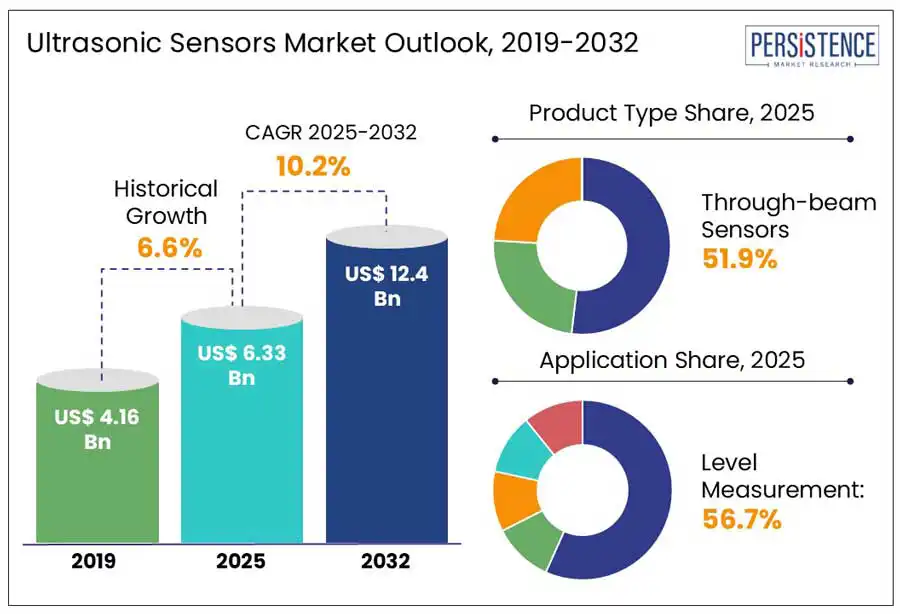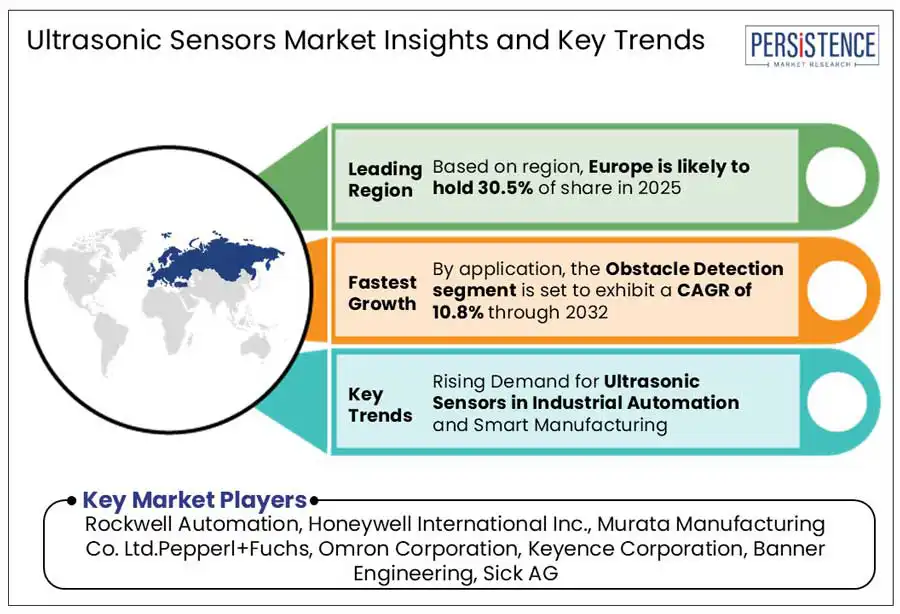ID: PMRREP33663| 180 Pages | 25 Apr 2025 | Format: PDF, Excel, PPT* | Semiconductor Electronics

The global ultrasonic sensors market is estimated to reach US$ 6.3 bn in 2025 and is expected to reach a value of US$ 12.4 bn to witness a CAGR of 10.2% by 2032. According to the Persistence Market Research report, factors such as increasing demand for autonomous and electric vehicles (EVs), rising adoption of industrial automation and robotics, and growing deployment of ultrasonic sensors in the healthcare sector accelerates the market growth.

Key Industry Highlights:
|
Global Market Attribute |
Key Insights |
|
Ultrasonic Sensors Market Size (2025E) |
US$ 6.3 Bn |
|
Projected Market Value (2032F) |
US$ 12.4 Bn |
|
Global Market Growth Rate (CAGR 2025 to 2032) |
10.2% |
|
Historical Market Growth Rate (CAGR 2019 to 2024) |
6.6% |
The aerospace and defense industry is experiencing significant growth, leading to increased demand for advanced sensor technologies, including ultrasonic sensors. In 2023, the U.S. A&D sector generated a total business output of US$ 955 billion, with direct industry contributions totaling US$ 533 billion and an additional US$ 422 billion coming from supply chain activities.
In Europe, the aerospace and defense industry recorded a 10.1% increase in turnover, reaching US$380 billion. This sustained growth is attributed to rising investments in military modernization, advanced aircraft systems, and unmanned aerial vehicles (UAVs), all requiring highly precise sensing solutions.
Ultrasonic sensors play a crucial role in these applications by enabling obstacle detection, structural integrity monitoring, and automated navigation for both manned and unmanned aircraft. As aerospace manufacturers prioritize safety and efficiency, the deployment of ultrasonic sensors in next-generation aircraft is expected to accelerate.
The commercial aerospace sector is also a significant driver of ultrasonic sensor adoption. With rising air traffic and increased aircraft production, safety regulations are becoming stricter, necessitating the integration of advanced sensing technologies. Ultrasonic sensors are extensively used in aircraft maintenance, helping to detect structural fatigue and prevent potential failures. The combined effects of increasing aerospace production, rising defense expenditures, and advancements in sensor technology are expected to drive the ultrasonic sensor market.
The increasing competition from more advanced sensing technologies, such as LiDAR, infrared, and vision-based systems, is expected to hinder the growth. LiDAR (Light Detection and Ranging) is favored in applications such as autonomous vehicles, smart infrastructure, and industrial automation due to its superior accuracy, higher resolution, and longer detection ranges. Unlike ultrasonic sensors, which depend on sound wave propagation, LiDAR can create detailed 3D maps of environments, significantly enhancing navigation capabilities.
Infrared sensors and camera-based vision systems are gaining popularity in applications requiring precise object recognition and surface texture analysis. For instance, in consumer electronics and smart home applications, optical sensors can more accurately detect human gestures, facial expressions, and subtle movements compared to ultrasonic sensors.
Radar technology is another emerging competitor to ultrasonic sensors which performs better in extreme weather conditions and long-range applications. Automotive manufacturers are increasingly turning to millimeter-wave radar for advanced driver assistance systems (ADAS) instead of ultrasonic sensors, as radar is less affected by environmental disturbances such as rain or fog. This trend towards adopting more advanced sensing technologies is likely to limit the use of ultrasonic sensors in certain high-precision applications.
The increasing adoption of Industry 4.0 and smart manufacturing technologies has created significant growth opportunities for ultrasonic sensors. As industries transition toward automation and robotics, real-time sensing and precision measurement solutions are becoming essential for improving efficiency and reducing downtime.
Ultrasonic sensors are widely used in industrial robotics, material handling, and quality control systems, enabling precise object detection, position tracking, and distance measurement. Rising investments in industrial investments due to labor shortages and efficiency demands, are expected to create significant growth opportunities.
Manufacturing plants and warehouses are increasingly integrating ultrasonic sensors for predictive maintenance and automated inspection of critical machinery. These sensors help detect surface defects, monitor liquid levels, and improve conveyor belt automation, ensuring seamless production workflows. Additionally, ultrasonic sensors are gaining traction in logistics and warehouse automation, for autonomous robots and AGVs (Automated Guided Vehicles) to navigate safely in dynamic environments. As industries continue to embrace smart automation and IoT-enabled manufacturing solutions, the ultrasonic sensor market is expected to experience sustained growth in industrial applications.
The Through-Beam Sensors segment is poised to dominate with a market share of nearly 52% in 2025. This dominance is primarily attributable to the superior performance of through-beam ultrasonic sensors, which offer high accuracy, long detection ranges, and reliability in various industrial applications.
Their ability to function efficiently in harsh conditions, including dust, moisture, and varying temperatures, makes them highly suitable for applications in the automotive, manufacturing, logistics, and robotics industries. Additionally, their fast response time and ability to detect transparent or irregularly shaped objects enhance their adoption across industrial automation and quality control systems.
The Level Measurement segment is set to lead accounting for a market share of 57% in 2025. This dominance is driven by the increasing adoption of ultrasonic sensors for precise and non-contact liquid and solid level monitoring across industries such as oil & gas, water and wastewater management, chemicals, pharmaceuticals, and food & beverages.
Ultrasonic level measurement sensors are widely preferred due to their high accuracy, durability, and ability to operate in harsh environments. These sensors use sound waves to detect fluid levels in tanks, silos, and reservoirs, making them ideal for applications requiring continuous and real-time level monitoring. Additionally, they offer advantages such as non-invasive measurement, low maintenance, and the ability to function in extreme temperatures and hazardous conditions, which are critical in industries such as chemical processing and petroleum storage.
Aerospace and Defense segment is poised to create significant growth opportunities till 2032. This substantial growth is driven by the increasing adoption of ultrasonic sensor technology in critical defense applications and next-generation aerospace systems. Ultrasonic sensors are widely used in aerospace and defense for distance measurement, obstacle detection, structural health monitoring, and advanced navigation systems. In military and defense applications, these sensors play a crucial role in unmanned aerial vehicles (UAVs), autonomous underwater vehicles (AUVs), missile guidance systems, and battlefield surveillance. Their ability to provide real-time, high-precision data in harsh environments makes them indispensable for military operations, where accuracy and reliability are crucial.

North America is set to create significant growth opportunities. This growth is majorly supported by the increasing adoption of ultrasonic sensing technology across industries such as automotive, healthcare, aerospace & defense, industrial automation, and smart infrastructure. One of the major factors fueling the demand for ultrasonic sensors in North America is the rapid advancement in autonomous vehicle technology. The region is home to leading automotive manufacturers and technology companies investing heavily in Advanced Driver Assistance Systems (ADAS), collision avoidance, and autonomous driving solutions.
The region witnessed a notable growth in the automotive sector, with car sales increasing by 15% and U.S. sales up by 14.4% in 2023. Similarly, production in North America grew by 12.4%, reaching 11.7 million units, with the U.S. producing over 7.6 million cars.
Europe is poised to dominate capturing a market share of 30.6% in 2025 at expanding at a CAGR of 9.7% by 2032. The region’s strong focus on Industry 4.0 and smart manufacturing has led to the widespread adoption of ultrasonic sensors for robotics, predictive maintenance, and industrial automation. The increasing deployment of IoT-enabled smart factories and AI-driven automation solutions is further fueling the need for high-precision ultrasonic sensing technology across various industries. The healthcare and medical devices sector in Europe is also a major driver of ultrasonic sensor adoption. These sensors are extensively used in non-invasive diagnostics, ultrasound imaging, and wearable health monitoring devices.
The global ultrasonic sensors market is moderately consolidated, with a few leading players holding a significant market presence. The market is characterized by technological advancements, strategic investments, and regional expansions as companies strive to strengthen their foothold in key industries such as automotive, healthcare, industrial automation, and smart infrastructure.
Manufacturers are increasingly incorporating IoT-enabled features, Bluetooth, and cloud-based data analytics to enhance real-time monitoring and remote accessibility. These advancements are catering to the growing demand for smart industrial automation, autonomous vehicles, and predictive maintenance solutions, allowing companies to differentiate their offerings in a highly competitive market.
The global ultrasonic sensors market is projected to value at US$ 6.3 Bn in 2025.
Factors such as increasing demand for autonomous and electric vehicles (EVs), rising adoption of industrial automation and robotics, and growing deployment of ultrasonic sensors in the healthcare sector.
The ultrasonic sensors market is poised to witness a CAGR of 10.2% from 2025 to or between 2025 and 2032.
Rising demand for ultrasonic sensors in industrial automation and smart manufacturing.
Major players in the ultrasonic sensors market include Rockwell Automation, Honeywell International Inc., Pepperl+Fuchs, Omron Corporation, Murata Manufacturing Co. Ltd., and others.
|
Attribute |
Details |
|
Forecast Period |
2025 to 2032 |
|
Historical Data Available for |
2019 to 2024 |
|
Market Analysis |
US$ Billion for Value Thousand Units for Volume |
|
Key Regions Covered |
|
|
Key Market Segments Covered |
|
|
Key Companies Profiled in the Report |
|
|
Report Coverage |
|
|
Customization & Pricing |
Available upon request |
By Product Type
By Application
By Industry
By Region
Delivery Timelines
For more information on this report and its delivery timelines please get in touch with our sales team.
About Author